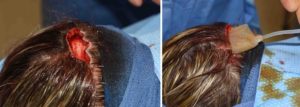Custom skull implants can be designed in virtually any shape or thickness. But just because it can be so designed does not mean that it can be safely placed or maintained. The ultimate success of any skull implant, particularly larger ones, is that the overlying scalp must have adequate stretch to accommodate it. This is extremely relevant at the time of placement as the scalp must be able to be closed over it. And even if it can be closed at the end of surgery, if the wound tension is too great, there a is a risk of eventual wound separation during recovery with implant exposure.
In larger custom skull implants there is a frequent need for a first stage scalp expansion phase. This is done with a temporary implant known as a tissue expander. Tissue expanders have a long history of use in scalp reconstruction to provide hair-bearing tissue coverage for lost or under desired portions of the scalp. Such pictures of their use can be found easily on the internet but this is not exactly how they are used for preparing the patient for large custom skull implants. The amount of tissue expansion is far less, only as much as is needed to fit the implant, and as a result the expansion time is far less.


After its placement the patient begins their expander inflations at home at a frequency of 10ccs every other or third day. The goal is 150cc to 200ccs if fill volume over a six week period. This has proven to be adequate for most large custom skull implant placements at the time of their second stage placement.
Dr. Barry Eppley
Indianapolis Indiana



